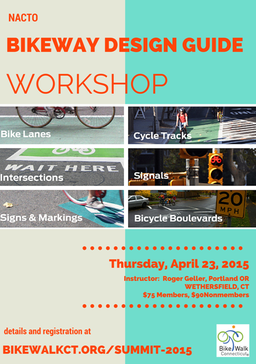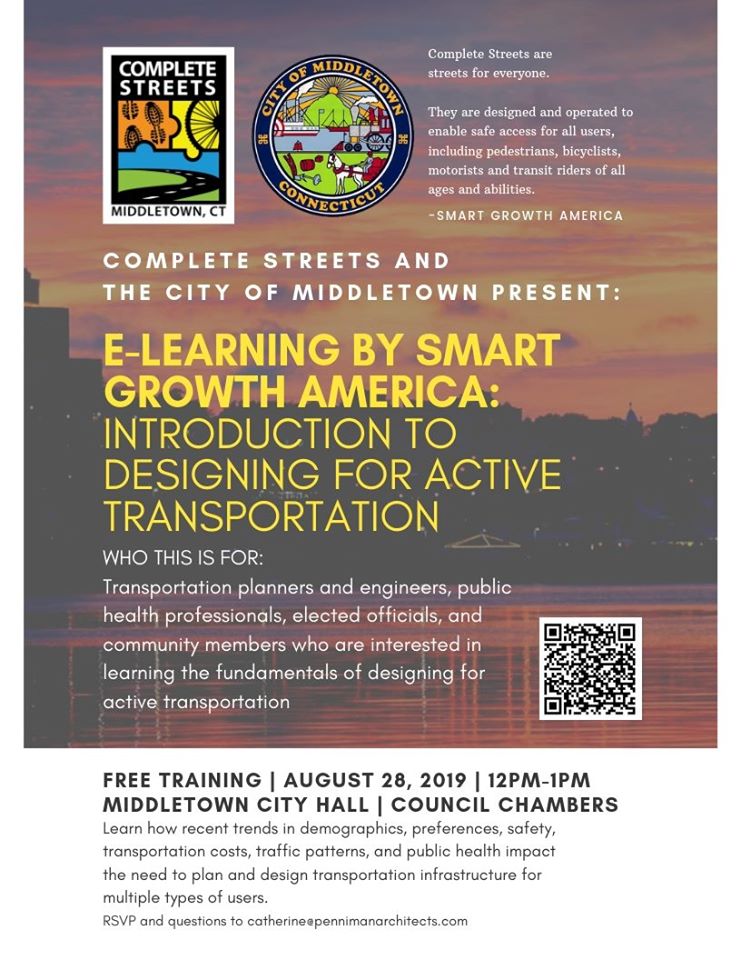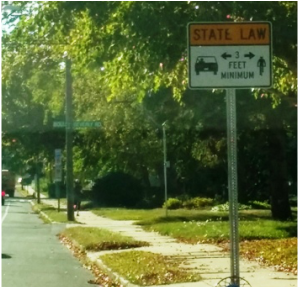|
Governing Magazine, widely read by the best thought leaders in government, ran a feature story recently noticing that the ‘complete streets’ movement is reshaping urban boulevards, small-town main streets and even rural highways and the "notion that roads should not be built just for cars and trucks is having profound effects on public spaces." Read the full story, then share it with your town council, planning, public works and engineering staff to bolster your case for getting your town on board. Roads Are Getting a RedesignThe first time Dean Ledbetter heard about “complete streets,” he thought it was a crazy idea. Ledbetter, a North Carolina traffic engineer, had devoted his career to creating roads that allowed cars to move faster. Complete streets would slow cars down, reworking roads to accommodate bicyclists, transit users and pedestrians, including people pushing baby strollers and riding in wheelchairs. Ledbetter’s first reaction, he says, was, “Why would you want to ruin a perfectly good road?” More.
Congratulations go out to West Hartford for becoming Connecticut's latest municipality to adopt its own complete streets policy. The West Hartford Town Council voted unanimously on July 21, 2015 to adopt a “Complete Streets” policy to comprehensively address the town’s streets for all users.
Bike West Hartford prompted the town to adopt a complete streets policy, working with the Bicycle Advisory Committee and Town Council last fall to pass a resolution calling for a complete streets policy within 180 days. (See Thumbs Up Awards, Oct. 2014). Since then, members of Bike West Hartford and the Bicycle Advisory Committee collaborated with town staff and town councilors on initial drafts. Town staff sought comments from relevant stakeholders, including Bike Walk Connecticut. Several drafts later, Town Council members Clare Kindall (and Bike Walk CT member) and Leon Davidoff, and Minority Leader Denise Hall, introduced the resolution to adopt the Complete Streets policy which they have been working on with Town Manager Ron Van Winkle and Community Services Director Mark McGovern since last summer. The policy was adopted unanimously. All transportation projects going forward, with limited exceptions, will follow the Complete Streets policy, Kindall said. The policy calls for a bicycle facilities plan to be developed by town staff with input from the Bicycle Advisory Committee,to be presented to the Council for adoption in the next nine months. The bicycle facilities plan will indicate the best routes for traveling through West Hartford by bicycle. Significantly, the policy also lists performance measures to be included in the Annual Report from the Town Manager to the Town Council, including:
Read West Hartford's full Complete Streets Policy and the accompanying resolution here. 35 Bike/Ped Accidents Since 2009, Claiming 6 Lives
East Hartford (August 4, 2015) - At the urging of advocates and after three years of planning and feasibility analysis, construction on Connecticut's first ever "road diet" has started on Burnside Avenue in East Hartford. Construction began on July 27 with completion scheduled for July 2016. At a press conference today, Governor Malloy, DOT Commissioner Jim Redeker and East Hartford Mayor Marcia LeClerc touted the project as a much-needed safety measure, and the first of more road diets to come. Redeker cited the project as an example of DOT's transition to a complete streets philosophy. The four-lane section of Route 44 on Burnside Avenue has been no friend to pedestrians cyclists over the years, with 35 bike and pedestrian accidents since 2009, claiming six lives. Generally, four-lane, relatively wide roadways encourage drivers to speed up, and high speed accidents are more likely to result in significant injuries or death. To make Burnside Avenue safer for pedestrians and cyclists, the road diet project will convert the existing four lane road to a two lane road with two 5 ft. bike lanes and two 7 ft. shoulders-- wide enough to preserve on-street parking. The road diet will cover the 2.76-mile stretch of Burnside Avenue between Main Street and Mary Street. According to East Hartford's Plan of Conservation and Development, the road diet will improve connectivity to other paths for bicyclists including streets with wide shoulders (e.g. Mary Street) and trails such as the Charter Oak Greenway. Planning for the road diet started in 2012 and included public meetings for DOT to share design concepts and hear from interested individuals. Construction was initially targeted for spring 2015 depending on funding availability. Ninety percent of the project is financed with federal funding, with the remaining 10% coming from the state. More information at: DOT - Summary, Fact Sheet; East Hartford POCD; TSTC: “Groundbreaking” ConnDOT Road Diet Must Be First of Many. Portland, Oregon's Roger Geller did not disappoint at today's Bikeway Design Workshop - not that we ever thought he would! Geller packed today's all day workshop with example after example of bikeway designs that make active transportation a way of life, sharing lessons learned by Portland and other cities along the way. The program was attended by about 80 engineers, public works professionals, planners and architects from across the state. We look forward to seeing the results of what everyone learned today.  Is your town attending the Bikeway Design Training on 4/23? Only if you're in Madison, Colchester, New Britain, Trumbull, New Haven or West Hartford--thanks to those towns for recognizing a great opportunity when they see one! Yikes! Don't let your town get left behind. Please encourage your municipal transportation professionals to attend.  West Hartford, CT (January 30, 2015) – Since last fall’s Pro Walk/ Pro Bike/ Pro Place conference, US Transportation Secretary Anthony Foxx has been clear that bicycle and pedestrian safety is his signature issue as the head of US DOT. As a former mayor, Foxx is well aware of the rising numbers of people who want to get around by bike and on foot, and the uptick in pedestrian and cyclist deaths and injuries. So at last week’s U.S. Conference of Mayors Winter Meeting, Foxx challenged those officials to help us help them make America's streets safer. The US DOT’s “Mayors' Challenge for Safer People and Safer Streets” invites mayors and local elected officials to take significant action to improve safety for bicycle riders and pedestrians of all ages and abilities over the next year. The Challenge will showcase best local practices to improve safety, share tools for local leaders to take action, and promote partnerships to advance pedestrian and bicycle safety. Participants will attend the Mayors' Summit for Safer People, Safer Streets in March 2015. Here’s what Foxx challenges mayors to do:
How individuals can get involved:
What we’re doing: Bike Walk Connecticut urges Connecticut’s chief elected officials to participate in the challenge and engage their residents in carrying out. These actions in the Mayors Challenge go to the heart of Bike Walk Connecticut’s mission, and we applaud Foxx’s leadership. Bike Walk Connecticut happily applauds the leadership of Connecticut Department of Transportation Commissioner James P. Redeker for signing a new “Complete Streets” policy for the DOT. The policy expressly promotes safe access for all users by providing a comprehensive, integrated, connected multi-modal network of transportation options. “We are committing ourselves to incorporating the objectives of complete streets in everything we do at the DOT,” said Commissioner Redeker. “As we plan and design new projects and other infrastructure improvements, this commitment will be front and center.” DOT's policy is intended to:
This policy includes procedures to directly address training for planning and design staff, project development checklists for bicycle and pedestrian design inclusion, more inclusive design guidance, access to public funding, expanded data collection and performance measures for all modes. Through data collection and performance measures the DOT will have the tools to effectively prioritize transportation spending and improve safety outcomes. “While the signing of this document is an important step for the Department, it is also a continuation of our commitment to Complete Streets,” Redeker said. “Currently, projects originating from our Office of Engineering routinely undergo a comprehensive assessment of bicycle and pedestrian needs and all Bureaus are working to better integrate the needs of all users into their projects and processes.” The Commissioner noted that Route 44 in East Hartford will undergo a “road diet” in 2015 to provide bike lanes, enhance vehicular safety and efficiency and improve pedestrian and transit accommodation throughout the corridor. The Department is also outfitting 50 train cars with bike racks on the New Haven Line operating between New Haven to New York City. CTfastrak, opening in 2015, is the state’s first fixed bus guide way running from New Britain to Hartford. It will enhance transit options for the capital region and provide a new multi-use trail facility from New Britain to Newington. In addition, the Watertown Bus Maintenance Facility will include an accommodation for the Naugatuck River Greenway providing riverside non-motorized access to the bus garage and transit stop. The DOT’s encroachment permit review will now include documentation of Complete Streets policy compliance. Read the DOT Complete Streets Policy Statement. See our Complete Streets Initiative. For those who want to geek out on how state DOT design manuals can affect
bike- and ped-friendly streets, SSTI will hold a webinar on Tuesday Ocotber 21 featuring two people that helped "rewrite the book" in New Jersey and Massachusetts. Tuesday, October 21, 2 pm Eastern Rewriting the book: Context sensitivity design in roadway design and project development REGISTER HERE Eight years ago, both Massachusetts and New Jersey rewrote the book. Massachusetts entirely rewrote its design manual to incorporate a multi-modal, context sensitive approach to roadway design and project development . New Jersey joined Pennsylvania in writing an overlay to their manual interpreting standards in a context sensitive way. Both efforts changed the states? approach to design and project development. Our two webinar speakers worked for MassDOT and NJDOT and led the efforts in these two states. We wondered: Has anything changed? What was the process for the rewrite and how did they overcome resistance from internal DOT staff, politicians, and the public? What would they do different today, and what are the lessons learned? And is there more to do to design roads for the 21st Century? Join Luisa Paiewonsky, Safety and Operations Program Manager at Volpe National Transportation Systems Center, and Gary Toth, Senior Director, Transportation Initiatives at Project for Public Spaces to hear their perspectives on rewriting the book and new standards for design. More information and registration here: http://www.ssti.us/Events/rewriting-the-book-context-sensitivity-design-in-roadway-design-and-project-development/
|
Bike Walk Connecticut
NEWS Send us your bike walk related news and time permitting, we'll do our best to post it.
Topics
All
|
Photo from Roebot




